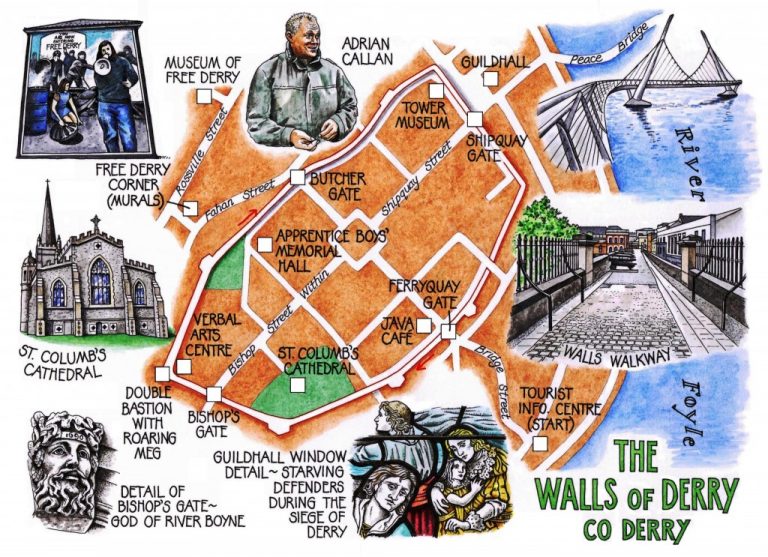Irish Independent Walk of the Week Christopher Somerville
23 July 2011
No 105: The Walls of Derry, Co. Derry

‘This place was probably just a druidical oak grove when St Columbkille founded his monastery here in 546AD,’ said Adrian Callan as we walked the Walls of Derry. ‘We’ve come a bit of a journey since then.’
That was a true word. Notwithstanding the slow growth of the ‘town of oaks’ beside the River Foyle, it was the building of Derry’s city walls in 1613-18 that gave the place a new coherence and a new prosperity. The city received a new name, too – Londonderry – to reflect the place of origin of the rich English livery companies that funded, and profited from, this transformation. Not only do those 400-year-old walls and their original gateways still stand: they are in wonderful repair, a tight belt of stone strapping the 17th-century city to its hilltop in defiance of all comers. Strolling the broad walkway and looking inward onto neat streets of well-kept houses, you’re aware of a notable civic pride and energy about the place.
At the ornate Bishop’s Gate, Adrian pointed west. ‘King James II thought he could take Derry without much trouble when he arrived here in April 1689. But he’d not reckoned with the mood of the Protestants in the city.’ Nearby St Columb’s Cathedral serves as a museum of the Siege of Derry, telling the remarkable story of how the defenders held out for 15 weeks after the famed (and maybe mythological) Apprentice Boys seized the city keys and locked the gates against the Catholic besiegers. By the time the siege was finally lifted in July, a quarter of the 30,000 citizens inside the walls lay dead of starvation, disease or wounds. Every dog, cat, horse and cow in the place had been eaten, and most of the rats and mice too.
Walking on, we came to the Double Bastion with its two apt symbols of Derry new and old. The Verbal Arts Centre on the walls is all about exchange of views through story-telling, communication and the meeting of minds and the people that possess them. Just along the way the iconic cannon Roaring Meg, her breech stamped ‘Fishmongers, London, 1642’ in acknowledgement of the Livery Company that paid for her, points out towards the big housing estate that lies to the north below the walls. ‘The Bogside,’ said Adrian, ‘and that street over there is where I was born.’
You can’t really get a proper perspective on Derry’s tangled history from the walls alone. We passed the Apprentice Boys’ Memorial Hall and went out of Butcher Gate. Down on Free Derry Corner at the entrance to the Bogside, the murals stood large and passionate in dark blue, grey and black – Bernadette Devlin in tight jeans hollering into a megaphone, a boy in a gas-mask clutching a petrol bomb, figures running and choking in clouds of tear gas. Adrian had vivid stories of what it meant to be a Bogsider in the 1970s. Along the street in the Free Derry Museum, the displays, the desperate newspaper headlines and the jarring soundtrack all brought those dark days vividly to life.
Dark days produce dark humour to shine a chink of light. We heard of the traveller who brought his donkey to the Bogside and coolly set about removing the engine of a bus that had been jammed into a barricade. And then there was the time that a brand new bus had been commandeered, and the bus company sent a message asking if the barricade-builders would mind swapping it for an old one.
Back on the walls once more we made a tour of the excellent history display in the Tower Museum, and admired the superb stained glass windows in the Guildhall. Spanning the Foyle beyond was the graceful arc of the newly-opened Pearce Bridge, sign of the times and of hopes for the future.
A walk round the Walls of Derry is not a stroll in the park – it is a walk through dour and bloody history. But it’s also a walk about hope and transcendence. History is clinging stuff, but it needn’t drag us down – that’s what we saw and heard on this memorable perambulation.
WAY TO GO
Map: OS of Ireland 1:50,000 Discovery Sheet 7; city centre map from TIC.
TRAVEL: Rail/bus (nirailways.co.uk): Derry
Road: From Belfast, M2, M22, A6. Car park signed beside TIC on Foyle Embankment.
WALK: From TIC, up Bridge Street (opposite) to Ferryquay Gate. Left along walls walkway. At Bishop’s Gate, descent to visit St Columb’s Cathedral. Return to walls and continue. At Butcher Gate leave walled city; descent Fahan St to Free Derry Corner. Right along Rossville Street to Museum of Free Derry. Continue to roundabout; right to return to walled city at Tower Museum. Guildhall is opposite. Return to walls at Shipquay Gate; left to Ferryquay Gate and return to TIC.
LENGTH: Allow half a day
GRADE: Easy
DON’T MISS: Ornate wall gates; St Columb’s Cathedral and Chapter House Museum; Walker’s Plinth; Free Derry Corner, murals and Museum of Free Derry; Tower Museum, Guildhall windows.
REFRESHMENTS: Plenty of options in Derry – try Java Café, Artillery Street, opposite Ferryquay Gate (026-7136-2100)
GUIDE: Adrian Callan (07793-525478)
ST COLUMB’S CATHEDRAL: London Street (026-7126-7313)
MUSEUM OF FREE DERRY: 55 Glenfada Park, Bogside (026-7136-0886)
TOWER MUSEUM: Union Hall Place (026-7137-2411)
GUILDHALL: Guildhall Square (026-7137-7335)
INFORMATION: Walking tour operators, local walks including Discover Ireland’s National Loop Walks and Northern Ireland’s Quality Walks, walking festivals throughout Ireland: www.walkni.com; www.discoverireland.ie/walking
DERRY TIC: 44 Foyle Street, Derry BT48 6AT (026-7126-7284; derryvisitor.com)
csomerville@independent.ie
I plan to escort a group to Derry in May 2017. We will be in the city for three nights.
The group size,hopefully, will be about 20 in total.
I would like to hire two guides.
Can you please let me know how I go about doing this?
Thank you,
Alan